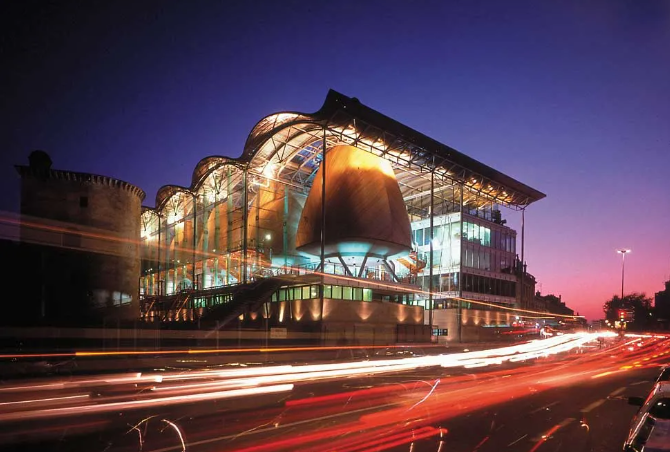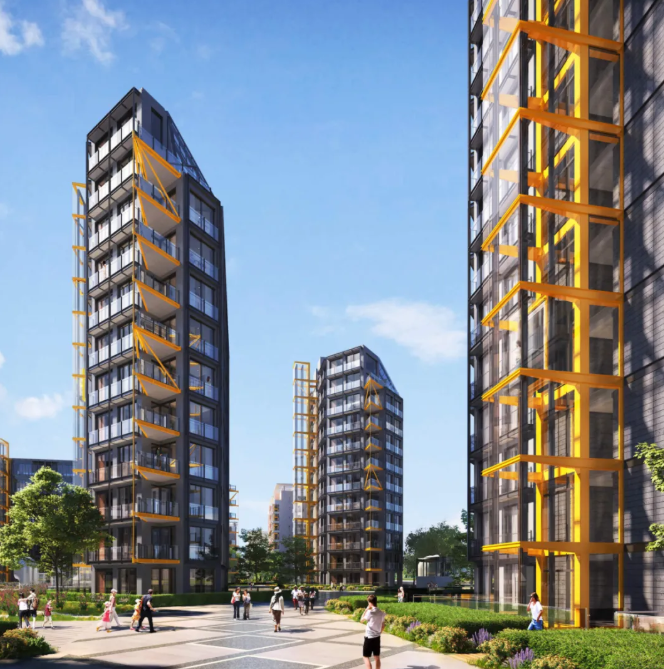Richard Rogers passes away, looking back on his colorful life
When the Pompidou Square was completed in 1977, Rogers established Richard Rogers Partnership (Richard Rogers Partnership), which was renamed Rogers Stirk Harbour + Partners in 2007, which is what we now know as RSHP. Richard explained the name behind the change "I don’t want a situation in the future where the office is named after a person who died a hundred years ago. The building itself has its own life. If I want to leave something to the future, it must be able to be changed, and at the same time It can also retain our spirit for fifty years."

Pritzker Prize winner, British architect Richard Rogers died at his home in London on December 18, local time, at the age of 88. His colorful modernist architecture changed the urban landscape of Paris and London forever .
Rogers was born in Florence, Italy in 1933, and moved back to the UK with his family four years later. After studying at the Architectural Association of London (AA), he then studied at Yale University in the United States, where he became interested in Wright's work. In 1963, he co-founded Team 4 construction company with Norman Foster, Susan Brumwell and Wendy Cheesman. This small group soon dissolved; in 1971, Rogers and Renzo Piano were established Piano & Rogers Architects, during this period, they created the Pompidou Art Center for the high-tech handed down work.

Rogers received all the highest honors an architect can have: he won the British RIBA (Royal Institute of Architects) Gold Medal in 1985, and his work twice won the RIBA Stirling Prize for architectural works; he won the tenth in 2006 The "Lifetime Honor Golden Lion Award" at the Venice Architecture Biennale; he won the Pritzker Architecture Prize in 2007, and he is the fourth British person to receive this honor; he won the AIA (American Institute of Architects) Gold Medal in 2019. Here are ten of the most well-known or interesting buildings in his career.
01
Centre Pompidou
1977, Paris, France
In 1970, the architect Richard Rogers, who was not well-known at the time, collaborated with Renzo Piano to create one of the most famous and revolutionary buildings of our time, the Pompidou National Art and Culture center. This cultural center located in Paris, France is not an exaggeration to subvert our world. The Pompidou Center is an example of constructivism. It is a high-tech modern cultural center. Its structure is composed of a kind of small Gebel and trusses, which were not seen in the previous architectural world. One of their concepts is to portray the museum itself as dynamic, and perhaps the most obvious one is to expose all the infrastructure of the building. The skeleton itself encloses the building from the outside, showing all the different mechanical and structural systems, not only can be used to understand the structure of the building more concisely, but also can maximize the internal space and eliminate the sense of partition in common buildings. Different systems on the exterior of the building are painted in different colors to distinguish their different roles. One of the most famous "moving" elements in the center is the escalator on the west facade (painted in red at the bottom), a pipe that twists and rises to the top of the building, providing visitors with an amazing view of the city of Paris .

02
Lloyd Building
1986, London, England
Following the success of Richard Rogers and Renzo Piano at the great Pompidou Centre in Paris (1977), Rogers designed the Lloyd Building to replace the original headquarters of the insurance company in the medieval financial district of London. The design of the Lloyd Building is similar to that of the Pompidou Center, with all the service functions removed from the interior and placed on the exterior of the building. The building consists of three main towers centered around a 60-meter-high atrium located in the center of the building. Each main tower is connected to its own service tower. Each floor acts as a corridor overlooking the atrium. However, only the bottom four floors are open to the atrium, and the remaining floors are surrounded by glass curtain walls. The entire building is covered with stainless steel to present a high-tech, post-modern aesthetic. The streamlined fa?ade is juxtaposed with mechanical and service functions on the outside, which not only leads to technical improvements in its structure, but also expresses the focus of the building's design on its functionality. The futuristic Lloyd's Building in London has become one of the few post-modern buildings that have been granted Grade 1 protection.

03
Millennium Dome
2000, London, UK
The Millennium Dome is the focus of a larger master plan by Richard Rogers for the Greenwich Peninsula on the south bank of the Thames in London. It was originally designed to accommodate the national holiday organized by the United Kingdom to commemorate the year 2000— —"Millennium Experience". But although the "Millennium Experience" came to an end in 2000, the Millennium Dome was later used for various purposes, and its durability is mainly attributed to Richard Rogers's flexible design. The design of the dome features a circle of twelve steel masts up to 100 meters high, which support a high-strength cable network. The 70-kilometer-long cable is covered by a white Teflon fabric ceiling that is only one millimeter thick, and its internal lining can absorb sound and condensation. The specifications of the dome are amazing: its circumference is one kilometer, the top height is 50 meters, and it covers an area of 80,000 square meters. In keeping with the festive spirit of the exhibitions it hosts, the architecture of the dome aims to convey an optimism for the new millennium.

04
Madrid-Barajas Airport
2006, Madrid, Spain
Rogers retained the original design concept and responded to complex and extensive specification requirements, organizing activities in the three buildings. The terminal building is characterized by three linear modules (boarding gate spine, processing spine, dock), and provides different functions according to passenger flow (arrival or departure). These modules are separated by a light-filled ‘canyon’ to provide natural lighting for the lower floors of the building, which helps to reduce energy consumption and also reduces maintenance and upkeep costs. In these spaces, passengers can move vertically through stairs, ramps or elevators. These are a very important element for the positioning of passengers, because they indicate the sequence of actions that passengers need to take when arriving or leaving. Despite the large scale of the project, the design of Barajas Airport did not sacrifice the functionality and comfort of the building. As a city and architectural space, the airport has a humanized scale both externally and internally, and coexists in harmony with the surrounding environment. , To minimize the impact on the environment.

05
One Hyde Park
2009, London, UK
One Hyde Park is located in the heart of Knightsbridge. It is a well-known new development project, including professionally designed luxury apartments and duplex buildings.

06
122 Leading Street
2014, London, UK
This building is composed of unique industrial elements, and the expression of the whole building and its components is very clear. These elements include the main force-bearing structure, the trapezoidal frame, the office floor, the northern supporting core and the external envelope structure. The structure is designed to strengthen the geometric shape defined by the development envelope, which in turn creates a unique gradual form, and adopts the form of peripheral supporting "tubes" to define the extent of the floor. The trapezoidal frame helps to emphasize the vertical direction of the building and enclose the fire-fighting core that serves the office floors. The frame also visually fixes the building to the ground.

07
London School of Economics and Political Science Centre Building
2019, London, UK
Rogers Stirk Harbour + Partners (RSHP) designed this building that reflects the values of the London School of Economics and Political Science. The project reached the highest level of "Outstanding" (Outstanding) of the building sustainability rating system BREEAM, and reached the goal set in the design task book. The project provides innovative and inspiring teaching spaces, including a new "London School of Economics and Political Science" lecture hall, and provides departmental space to encourage cooperation and exchanges between departments.

08
Richard Rogers Retirement: 27-meter Steel Cantilever Gallery
2021, 13610 Le Puy-Saint-Repard, France
RSHP recently completed the construction of the Richard Rogers Gallery. The 120-square-meter project officially started in June 2020, which is just before Richard Rogers’s retirement. The gallery is located on the 500-acre Chateau La Coste. In order to minimize the impact of the completed structure on the local ecology, the architect designed a 27-meter large cantilever, which is 18 meters above the surrounding woodland.

09
Bordeaux Court
1992-1998, Bordeaux, France
Richard Rogers won an international competition to design a new court for the historic city of Bordeaux in 1992. The project hopes to encourage a sense of direction through transparent and open design techniques and make a long-established institution more accessible. The key elements of the design include creating public space and integrating with the existing urban landscape, while completely separating judicial and public passages. The public enters the building through a staircase placed on the side, leading to the "Salle des Pas Perdus" at the core of the building, where lawyers, their clients and the public meet. The seven courtroom "capsules" are clad in cedar wood and are placed on overhead columns above the limestone base in the huge glass curtain wall under the undulating copper roof.

10
Shanghai Pudong Qiantan Residential District
2015 to present, Shanghai, China
At the center of the Shanghai Pudong Qiantan residential area is a wide central garden, creating a quiet and peaceful oasis for residents, allowing them to stroll and relax on the way into the building. Three of the residential towers are parallel to the river to maintain the visual frontage. In order to allow residents to enjoy the beautiful views of the Huangpu River and the skyline of Shanghai and Lujiazui from the depths of the project, these towers are staggered, and the non-square building plan maximizes these landscape corridors.




